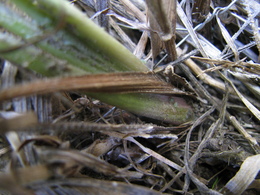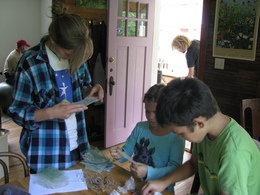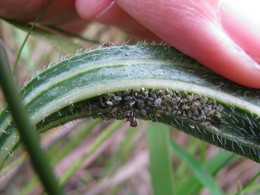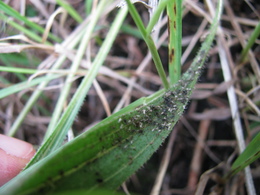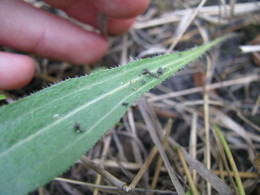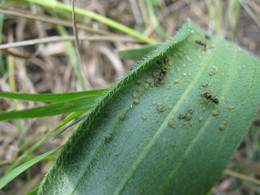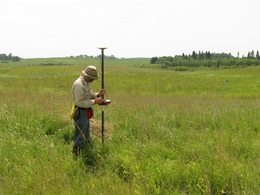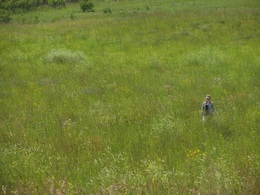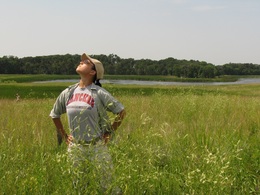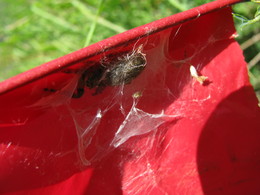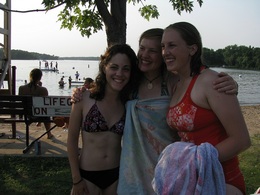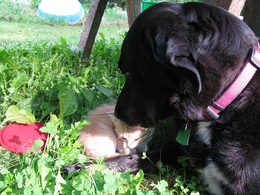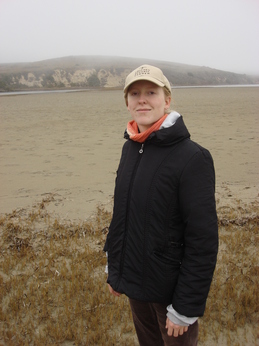|
|
Like their hosts, Echinacea aphids exhibit a strong seasonality. There’s a sharp rise in the frequency and abundance of aphid infestation followed by a rapid decline in early fall. That decline has occurred much earlier this year than last year. Fortunately, that has given me a chance to make some observations about what happens to aphids at the end of the summer. Here are a few things I’ve noticed:
1. Throughout my surveys in CG1 and several prairie remnants, I’ve noticed that the frequency of winged morphs has declined since July. Last week, I did not see any winged aphids, with the exception of a couple at East Elk Lake Road. This implies that dispersal declines as aphid numbers drop.
2. I and several others have noticed that aphids are starting to congregate at the base of the plant both at the petioles and at the base of the stem. I’ve also seen aphids crawling down beneath the soil surface and a few latched onto the tops of roots. One possibility is that as plants withdraw resources from their leaves, aphids move down the plant to follow their food source. I’ve also seen ants moving aphids at the base of the plant and placing them in dirt structures. These observations support the notion that aphids overwinter on Echinacea roots.
Many aphid species in temperate regions spend the winter and summer on different plants. Their winter host is where they lay eggs and their summer host is where they feed and reproduce asexually. My guess is that Aphis echinaceae does not have a separate winter host.
This plant at Nessman’s had a bunch of aphids congregated at the base. Notice the little green guys on the stem:

This is one of the plants from my aphid addition/exclusion experiment in CG1. There are still aphids on the leaves, but most of them have moved to the petioles:

Tuesday was a cool, windy day with scattered rain showers. In the morning we descended on KJ’s, a small site chocked full of Echinacea, to check on seedlings in Amy’s recruitment study. We made some progress, but we have a long way to go at that site.
In the afternoon, we all crammed into the pickup truck and rode over to Krusmark’s, an isolated site near the Wagenius property. Maria was especially excited to ride in the truck bed. We collected demography data on flowering plants and gathered seed from sideoats gramma grass (Bouteloua curtipendula) to scatter in the main experimental plot.
Since there were not many flowering plants, we finished up in time to catch up on chores around the field station. Here’s the Wagenius kids helping Shona clean up after her pollination crossing experiment. She and several others developed a wire contraption to keep the pollinator exclusion bags away from the anthers.

It is bittersweet to see a good summer coming to a close. Lydia left on Sunday, Andrew’s leaving on Wednesday, and Shona will head out on Friday. Although we are sad to see them go, we have plenty of work to distract us from our sorrow.
It was a dark and stormy morning. With the exception of Jill, Maria, and I, the members of team Echinacea bided their time at the old town hall waiting for the rain to diminish. The three of us had indoor tasks to work on–specifically, sorting ants and entering data. After the sky had exhausted itself, a group of us went to a large site at East Elk Lake Road to search for flowering plants for the annual Echinacea demography census. We had searched the site before, but the cloud cover made prime conditions for finding Echinacea among the shrubs and trees. Stuart, Maria, and Andrew went to another large and difficult-to-search site (Aanenson) to take GPS points on plants.
After that, several of us began censusing Riley, a roadside remnant. The site is full of flowering plants, many of which are growing in the road. Because of this, many of the plants have lost their heads due to mowing. The team finished Riley in the afternoon, leaving enough time to census a nearby site we call Woody’s.
I spent the afternoon excluding aphids from plants in my aphid addition/exclusion experiment. Aphid infestation is clearly on the decline for the season. Each time I perform aphid exclusion, I record the number of aphids present on the plant before I remove them. This time yielded the lowest aphid counts in my exclusion group this summer. I haven’t crunched the numbers yet, but based on my exclusion data I estimate that the peak of aphid season was probably between July 25th and August 1st. That is much earlier than last year, when the peak was between August 12th and 26th.
Last Saturday when I was performing aphid additions, I noticed that a lot of the plants in my addition group had colonies of dead aphids. For example, one plant that hosted nearly 2000 aphids on July 21st was down to 7 last Saturday. For an idea of what this transformation looks like, here’s a picture of a dense, thriving aphid colony:

And here’s a picture of a colony that has died off:

It is unclear why this happens so suddenly, considering the plant is still green. My guess is a surge of defensive chemicals in the plant.
On Thursday, all the undergraduates are going to the University of Minnesota for a poster session. They all did a great job on their research projects and put a lot of time and effort into their posters. I wish them all good luck in their presentations and look forward to hearing about their experience.
Saturday brought a resurgence of the “not-so-bad” weather we’ve been enjoying this week. Several rainstorms have brought some much needed moisture to the soil. The reason I mention this is that while I worked on my aphid addition/exclusion experiment, I noticed a lot of dirt mounds on plants where aphids were present. Presumably, ants build these structures to cultivate aphids. Some of these were small, consisting of only a few small pieces, and some were large, taking up a large portion of a leaf. Here’s one of the smaller examples. The opposite side of the leaf was covered in aphids.

Here’s a picture of one of the plants in my aphid addition group. As you can see, the ants are taking full advantage of the situation:

As for other field work, Kelly spent the morning checking the status of flowers for her phenology study. Most of the remnants have stopped flowering, with the exception of one plant at a small remnant and many at the Staffanson prairie preserve. Because the west half of Staffanson was burned in May, Echinacea began blooming later than in the unburned half.
In the evening, we all gathered at the Wagenius family home for potluck dinner and bonfire. I should say bonfires, since there were two right next to each other. Pyromanic desires were fulfilled by all.
This past weekend a group of us went over to Glacial Lakes State Park for some hiking and a change of scenery (i.e. trees). During our hike we passed a few sections of remnant prairie, evident by the presence of lead plant (Amorpha canescens). One of these had what appeared to be a flowering Echinacea angustifolia. Due to a combination of curiosity and habit, I walked over to check the plant for aphids. Sure enough, there they were:

They looked like Aphis echinaceae, though they were slightly bigger than the aphids I’ve seen around here. The reason I mention this is that the specimens for Aphis echinaceae were collected in our field sites throughout Douglas County. Glacial Lakes State Park is a little under 30 miles away. I didn’t collect any aphids, but I thought it was an observation worth sharing.
Monday was quite sultry, if I remember correctly. In the morning we divided forces to look at flowering phenology in C1 and to finish measuring the plants in Amy Dykstra’s experiment at Hegg Lake. She has two experimental plots there: one containing the offspring of inter-remnant crosses and the other containing seeds collected from source populations between Minnesota and South Dakota. She sowed seeds in 2008 and has been tracking their progress every year since. Once we finished finding and measuring plants, Stuart took GPS points for each experimental plot:

While he was doing that, Shona trekked off into the prairie to check on the plants in her hybridization experiment.

Meanwhile, Lydia and I waited by the truck and took advantage of the opportunity for an epic pose. I’d say it was successfully epic.

After last week’s sultry weather, we’ve been enjoying a “dry heat”, as Greg Diersen so artfully put it. This morning everyone went their separate ways to pursue their individual projects:
Shona, Maria, and Lydia went directly to Hegg Lake and combined forces to measure plants and take GPS points. Shona also photographed Echinacea pallida and E. angustifolia plants as part of her project to assess species traits.
Andrew searched the main experimental plot (C1) for plants where he can observe pollinators. Because peak flowering has passed, his selection of flowering heads is growing slimmer by the day. Fortunately, he has some good observations under his belt and will be able to collect more before plants stop flowering.
Jill and Greg joined forces in operation pit-fall trap. Greg’s traps are bowls full of soapy water that he sets on the ground and leaves out for a couple of days. Jill’s are tubes full of propylene glycol that she submerges in the soil and leaves out for a week. Today, they set out Greg’s traps and collected from Jill’s. I have to say: the smell of dead insects stewing in propylene glycol for a week is probably one of the worst smells I have experienced.
I spent the morning removing aphids from plants in my aphid addition/exclusion experiment. Even though it has been three days since my last exclusion, there were aphids on 11 out of 50 plants in my exclusion group. One plant had 67 aphids–all in three days! Those aphids are moving and breeding fast.
This afternoon we joined together in our common goal of measuring every plant in C1. My mother used to say that the only way to eat an elephant is one bite at a time. Well, today we bit a big chunk off of our elephant, finishing up the sections planted in 1997, 1998, and 1999. We have less than half an elephant to go!
And now for a picture. In addition to helping us keep track of plants, pin flags make great habitat for spiders:

We were all having so much fun on the 4th of July that I forgot to write the events of the day.
Technically, the 4th of July is a day off for the Echinacea crew. Plants don’t celebrate national holidays, so we spent the morning assessing flowering phenology in the main experimental plot. After that, Andrew experienced a series of unfortunate events that kept him from observing pollinators. On the upside, he learned some valuable lessons and made a new friend.
Because aphids don’t take holidays either, I spent the latter part of the morning visiting plants in my aphid addition/exclusion experiment to remove aphids from the exclusion group. The goal of my experiment is to capture the effects of aphids in natural conditions–i.e. no cages or bags. That means that in order keep aphids off of the plants in the exclusion group, I need to visit them every few days to remove them by hand. For fifty plants (plus fifty more in the addition group) that’s a lot of footwork.
We celebrated America’s national holiday with a picnic at Elk Lake. We crammed in as many all-American activities as we could: potlucking, canoeing, sand-castle building, frying in the sun. If things weren’t American enough, Stuart brought a print-out of the Declaration of Independence, which we all took turns reading around the picnic blanket. Go America!
I didn’t get a good group picture, but here’s a cute shot of Jill, Shona, and Kelly:

Here are the day’s events:
When we arrived at work this morning we came upon a poignant scene. The Wagenius’ family dog, Roxie, had was nurturing an abandoned kitten:

I’m happy to say the poor creature has found a home with Kelly and her parents. Thanks to her loving care (and Roxie’s), it is now purring and mewling with gusto.
Once the kitty situation was resolved, we moved on to more serious business. Shona, Maria, Kelly, and Lydia spent the morning working on their individual projects while the rest of us assessed flowering phenology in two experimental plots (C1 and C2).
A lot of work goes into maintaining an experimental plot. In order to keep C1 from being overgrown by woody plants, several of us spent the afternoon trimming ash trees and sumac. The rest of us made progress on our individual projects. Thanks to help from Kelly and Lydia, Jill and I succeeded in setting up ant traps for all but one of our field sites. I’ll post more about that later.
I don’t know if I’ve properly introduced myself on here.
My name is Katherine Muller and I’m a second year Master’s student at Northwestern. I hail from the lovely, temperate San Francisco Bay Area. I’m not sure whether it was my thirst for adventure or my contrarian nature that led me to the Midwest–first to Oberlin College in Ohio, then to Northwestern and Minnesota. In any case, I now have the privilege of complaining about the weather.
This is my second year with the Echinacea Project. Last year I began research on aphids and ants in Echinacea angustifolia. I have two projects that I plan to continue this summer:
My first project is an experiment examining the effects of aphid infestation on Echinacea. Last year, I selected 100 non-flowering Echinacea, excluded aphids from 50 plants and added aphids to the other 50. I am repeating the experiment on the same plants. I performed my first experimental treatments on Saturday and Sunday and should soon be able to analyze my results from last year.
The other project I plan to continue this year is a survey of aphids and ants in a large experimental common garden. Last year I selected a 20x20m section of the experimental plot and led a biweekly of ants and aphids. I started this because I was interested in seeing how aphids spread over space and time. This year I will examine the same area to see how aphid infestation changes from year to year. Thanks to everyone’s help, I collected my first dataset on June 15th. Considering the unusually warm winter, there should be some interesting developments this year.
My third project is to assess aphid and ant abundance among several Echinacea populations. My original plan was to survey aphids and ants on a representative sample of the entire population, including juvenile and non-flowering plants. As it so happens, Amy Dykstra and Daniel Rath conducted a similar survey in 2009 (you can read about it in the archives). For all their hard work, they found very few plants with aphids. Of the plants they surveyed–flowering plants had a much higher rate of aphid infestation than non-flowering plants–32% for flowering versus 5% for non-flowering plants. I decided to take a different approach and focus my sampling effort on flowering plants. Specifically, I will survey aphid and ant abundance on plants that flowered this year and last year. This will allow me to assess whether flowering in one year influences the likelihood of aphid infestation the following year.
That’s about it for now. I’ll be posting my progress on here as it happens. This summer I have the privilege of collaborating with Jill Gall, an REU student from College of the Atlantic. She’s been hard at work preparing her project assessing ant diversity in prairie remnants, which I’ll let her tell you about.
And because everyone else is doing it, here’s a picture:

|
|
